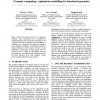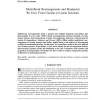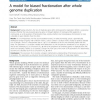680 search results - page 1 / 136 » Genomic computing: explanatory modelling for functional geno... |
GECCO
2000
Springer
13 years 8 months ago
2000
Springer
Many newly discovered genes are of unknown function. DNA microarrays are a method for determining the expression levels of all genes in an organism for which a complete genome seq...
JCB
2008
13 years 4 months ago
2008
Multi-break rearrangements break a genome into multiple fragments and further glue them together in a new order. While 2-break rearrangements represent standard reversals, fusions...
RECOMB
2012
Springer
11 years 7 months ago
2012
Springer
Background: Paralog reduction, the loss of duplicate genes after whole genome duplication (WGD) is a pervasive process. Whether this loss proceeds gene by gene or through deletion...
NAR
2011
12 years 7 months ago
2011
Tomato Functional Genomics Database (TFGD) provides a comprehensive resource to store, query, mine, analyze, visualize and integrate large-scale tomato functional genomics data se...
BMCBI
2006
13 years 4 months ago
2006
Background: Expression array data are used to predict biological functions of uncharacterized genes by comparing their expression profiles to those of characterized genes. While b...




